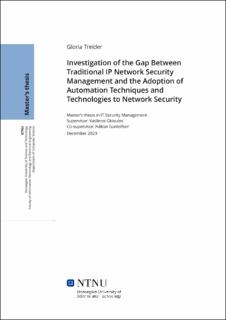| dc.contributor.advisor | Gkioulos, Vasileios | |
| dc.contributor.advisor | Gunleifsen, Håkon | |
| dc.contributor.author | Treider, Gloria | |
| dc.date.accessioned | 2024-02-17T18:19:40Z | |
| dc.date.available | 2024-02-17T18:19:40Z | |
| dc.date.issued | 2023 | |
| dc.identifier | no.ntnu:inspera:155686180:34812545 | |
| dc.identifier.uri | https://hdl.handle.net/11250/3118326 | |
| dc.description.abstract | Innenfor området nettverks- og nettverkssikkerhetsautomatisering avdekker denne oppgaven et komplekst landskap av utfordringer og muligheter. Forskningen som er gjennomført, belyser de intrikate elementene som er innebygd i automatiseringen av store IP-nettverk, noe som igjen fører til en transformasjon i perspektivene til organisatoriske ledere som har ansvaret for nettverksstyring. Den sentrale målsetningen med denne oppgaven er å undersøke og underbygge det eksisterende gapet i bruken av nettverksautomatiseringsteknikker og -teknologier innen nettverks- og nettverkssikkerhetssystemer. Det gir klarhet på flere dimensjoner innenfor det komplekse landskapet, og hjelper organisasjoner med beslutningstakingen når de vurderer løsninger for automatiseringsteknikker.
For å oppnå dette målet, undersøker vi kritisk den samtidsorienterte litteraturen om nettverkssikkerhet og automatisering, og tilbyr en grundig gjennomgang av tradisjonelle nettverkssikkerhetsmetodikker, samt de potensielle automatiseringsteknikkene som er tilgjengelige for å forbedre nettverkssikkerheten. I tillegg analyserer vi faktorer som påvirker implementeringen av nettverkssikkerhetsautomatisering gjennom grundige undersøkelser og intervjuer. Våre funn understreker nettverksautomatiseringens mangfoldige natur og belyser det komplekse landskapet organisasjoner skal navigere når de vurderer automatiseringsløsninger. Ved å adressere gapet i dagens tilstand for nettverksautomatisering, bidrar vi til en dypere forståelse av dette stadig utviklende feltet.
Valideringen av våre funn innebærer samhandling med to forskjellige grupper deltakere, akademiske
fagpersoner innen IT-utdanning og erfarne IT-fagfolk som er ansvarlige for styring av omfattende nettverk. Deres innsikt, erfaringer, og forslag fungerer som en verdifull bekreftelse av vår forskning, og gir et helhetlig perspektiv på automatiseringen av nettverks- og nettverkssikkerhetsprosesser.
Avslutningsvis fungerer vår forskning som en katalysator for endring innen feltet for nettverksautomatisering.
Vi fremhever eksistensen av organisatoriske siloer og understreker viktigheten av å bryte ned disse barrierene for å oppnå det overordnede målet om å automatisere oppgaver innen nettverks- og nettverkssikkerhet. Vårt arbeid er i ferd med å øke bevisstheten blant interessenter og inspirere til meningsfulle endringer i nettverksstyringsparadigmer. | |
| dc.description.abstract | In the realm of network and network security automation, this thesis unveils a complex landscape of challenges and opportunities. The research sheds light on the intricacies inherent in automating large IP networks, prompting a transformation in the perspectives of organizational leaders tasked with network management. The central objective of this thesis is to investigate and substantiate the existing gap in the application of network automation techniques and technologies within network and network security systems. It clarifies multiple dimensions within the complex landscape, assisting organizations in their decision-making when evaluating automation technique solutions.
To achieve this goal, we critically examine the contemporary literature on network security and automation, offering a comprehensive review of traditional network security methodologies alongside the potential automation techniques available for enhancing network security. Additionally, we analyze factors influencing the adoption of network security automation through rigorous surveys and interviews.
Our findings underscore the multifaceted nature of network automation, illuminating the complex landscape that organizations shall navigate when considering automation solutions. By addressing the gap in the current state of network automation, we contribute to a deeper understanding of this evolving field.
The validation of our findings involves engaging with two distinct groups of participants, academic professionals in IT education and experienced IT professionals responsible for managing extensive networks. Their insights, experiences, and suggestions validate our research, providing a holistic perspective on the automation of network and network security processes. In conclusion, our research catalyzes change within the field of network automation. We highlight the existence of organizational silos and emphasize that breaking down these barriers is essential for achieving the overarching goal of automating network and network security tasks. Our work is poised to raise awareness among stakeholders and inspire meaningful shifts in network management paradigms. | |
| dc.language | eng | |
| dc.publisher | NTNU | |
| dc.title | Investigation of the Gap Between Traditional IP Network Security Management and the Adoption of Automation Techniques and Technologies to Network Security | |
| dc.type | Master thesis | |
